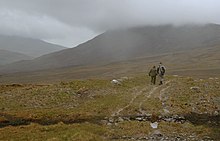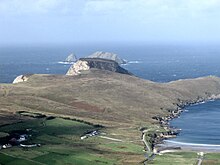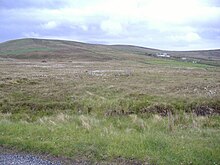Erris
Erris
Iorras | |
|---|---|
Barony | |
IST (WEST )) | |
| Dialing code | +353 41 |
Erris is a
There are five
.Gaeltacht

Parts of Erris are in a Gaeltacht area, with first-language speakers of Irish in the following areas of the barony: An Fál Mór, Tamhaiin na hUltaí, Glais, Eachléim, Tearmann, Tránn, An Mullach Rua, Cartúr, An Baile Úr, Cill Ghallagáin, Corrán Buí, Ceathrú na gCloch, Port a' Chluaidh, Ros Dumhach and Ceathrú Thaidhg. The area with the most Irish speakers is Ceathrú Thaidhg.[4] There are between 3,500-5,000 native Irish speakers in Erris.[citation needed]
Geography
Topography and geology

Much of inland Erris is covered with

Several areas of the blanket bog are protected under European legislation such as
Erris has a large range of habitats including
The oldest rocks in
"Erris Head" (Irish: Ceann Iorrais) is a promontory at the northernmost tip of the Mullet Peninsula. It is a landmark known well by mariners and is one of the sea areas cited by Met Éireann's weather forecasters.[12] The coastline of Erris has some of "the grandest sea cliffs in Ireland"[13] over the Atlantic Ocean from where the next stop is the east coast of America. Erris Head is not served by any road and can only be reached by crossing a number of fields from the hamlet of Glenlara where the road ends.Settlements and islands
Along the coast there are several uninhabited


Archaeology and history

Erris, in common with most of inland Ireland, became covered in extensive native woodland a few thousand years after the last Ice Age retreated (approx 15,000 years ago) but its northern and western shores remained relatively lightly afforested. Across inland Erris, the remains of these forests can be seen across the blanket bog landscape in the form of
During the
The period of
Some 19th- and early 20th-century
Rescue 116 search
The community of Erris gave support to the extensive search and rescue operation following the
Legend and folklore
Folklore is an important part of the culture of Erris.[23][24]
A number of well-known folklore tales have their origins in (or are associated with) the area. The Children of Lir, according to tradition, are buried on the island of Inisglora. The children were turned into swans by their jealous stepmother and doomed to spend the next 900 years on lakes and waters in Ireland. When they finally reclaimed their human form on Inisglora, they were so old that they died and were buried there.
Táin Bó Flidhais is the tale of a cattle raid in which raiders came to Erris from the Royal site at Cruachán (Rathcroghan) at Tulsk, County Roscommon to Rathmorgan Fort (Iorras Domhnann) at the south end of Carrowmore Lake in the centre of the Barony. The remains of Rathmorgan fort on top of the mountain can be seen from the road below.[25]
Brian Rua U'Cearbhain from Inver is remembered in folklore as the prophet of Erris.
The small village of Glencastle has some large mounds in the narrow valley that are not naturally occurring. They can be seen on the right hand side, close to the roadside on the approach to Belmullet from the east. These have never been archaeologically investigated but folklore legends recall that this was the old gateway into the Mullet and a toll had to be paid for each traveller who passed through or the traveller may never be seen again. There were no roads through this area of Mayo until less than two hundred years ago. In recent years the Glencastle Valley has been drastically altered by extensive quarrying.[26]
Water sports

Erris is a popular location for many types of
Walking trails
There are a number of walking trails in Erris. These include cliff walks above the
In 1993, the Tír Sáile Sculpture Trail project was carried out to commemorate 5,000 years of habitation in County Mayo.
Natural resources
Erris has considerable potential for ocean energy
Corrib gas field

The discovery of the Corrib gas field in the Atlantic Ocean some 85 km off Broadhaven Bay has led to the

Further reading
- Cronin, Phil. Traditional Cures and Gifted People (2000) Crossmolina
- Noone, Fr. S. Where the Sun Sets] (1991) Erris [1]
- Pipe Down - A documentary which won best feature documentary award at the Waterford Film Festival (2009)[2]
References
- ^ "From Ireland Genealogy & Family History". from-ireland.net. Archived from the original on 17 December 2010. Retrieved 28 July 2010.
- ISBN 1851094407.
- ^ Ireland's History in Maps - Baronies page 3
- ^ "School of Celtic Studies - The Irish of Erris, Co. Mayo: a phonemic study". Celt.dias.ie. Retrieved 5 June 2010.
- ^ "IPCC information sheets - Blanket Bogs". Ipcc.ie. 15 June 1919. Archived from the original on 2 October 2010. Retrieved 5 June 2010.
- ^ a b c "BirdWatch Mayo". BirdWatch Mayo. Archived from the original on 27 October 2010. Retrieved 5 June 2010.
- ^ a b "The Mullet Peninsula". birdwatchmayo.org. BirdWatch Mayo. Archived from the original on 16 July 2011. Retrieved 21 November 2018.
- ^ "Irish Geological Association". Geology.ie. 22 June 2008. Archived from the original on 21 July 2011. Retrieved 5 June 2010 – via Wayback Machine.

- )
- ISBN 9781897799116. Retrieved 5 June 2010.
- JSTOR 30002311.
- ^ "Sea Area Forecast - Met Éireann - The Irish Meteorological Service Online". Met.ie. 6 May 2010. Retrieved 5 June 2010.
- ^ "Mayo". Libraryireland.com. Retrieved 5 June 2010.
- ^ "Insihkea Islands". Irishislands.info. 28 October 1927. Retrieved 5 June 2010.
- ^ "Beautiful isles". Mayonews.ie. 5 August 2008. Archived from the original on 21 February 2014. Retrieved 5 June 2010.
- ^ "Inishglora". Irishislands.info. Retrieved 5 June 2010.
- ^ "Duvillaun". Irishislands.info. Retrieved 5 June 2010.
- ^ Erris Islands: moduvill, glora, inishkea
- ^ "IPCC information sheets - Pollen History Preserved in Bogs". Ipcc.ie. Archived from the original on 9 December 2010. Retrieved 5 June 2010 – via Wayback Machine.

- ^ For information on the archaeology of Kilcommon parish, see Comhar Dún Chaocháin Teo in Carrowteige.
- )
- ^ "Coast Guard and Catherine Corless honoured at People Of The Year awards". RTÉ.ie. 15 April 2018. Archived from the original on 16 April 2018. Retrieved 16 April 2018.
- ^ "Submission To Environment Protection Agency & Oral Hearing Request" (PDF). Erris Inshore Fisherman's Association. 15 February 2007 – via epa.ie.
- ^ "Irish Press Releases » Island Culture and Arts 24–26 July 2008 Belmullet". Irishpressreleases.ie. Archived from the original on 21 July 2011. Retrieved 5 June 2010 – via Wayback Machine.

- ^ "The Driving of Flidais' Cattle". Corona.edu. Archived from the original on 14 May 2010. Retrieved 5 June 2010 – via Wayback Machine.

- ^ "About". Lennonquarries.com. Archived from the original on 14 February 2015. Retrieved 5 June 2010.
- ^ "Erris Beo". Errisbeo.ie. Retrieved 5 June 2010.
- ^ "Mayo Walks - Erris Head Loop Walk". Mayowalks.ie. Archived from the original on 2 September 2010. Retrieved 5 June 2010.
- ^ "Walking book from Dun Chaochain area of North Mayo, Ireland". Mayo-ireland.ie. Retrieved 5 June 2010.
- ^ a b "Tír Sáile - The North Mayo Sculpture Trail". northmayoarttrail.com. Retrieved 30 October 2018.
- MayoNews.ie. 9 December 2008. Retrieved 5 June 2010.
- ^ "€160m wind farm to be built in Mayo". Farmers Journal. 24 May 2018. Archived from the original on 24 May 2018.
- ^ Western People - Wave farm in pipeline for Erris - October 2009
- ^ "SEAI - Sustainable Energy Ireland Commences Wave Energy Monitoring". Seai.ie. 23 February 2010. Archived from the original on 5 March 2016. Retrieved 5 June 2010.
- ^ "Renewable Energy Strategy". mayococo.ie. Mayo County Council. Archived from the original on 17 April 2010.
- ^ "Prime Time". RTÉ News. 5 July 2015. Archived from the original on 2 November 2012.
- ^ "The Pipe". Undergroundfilms.ie. Archived from the original on 12 March 2010.


